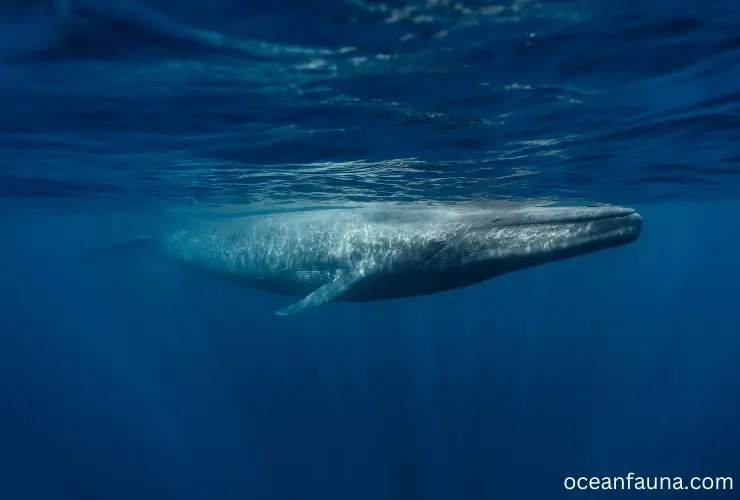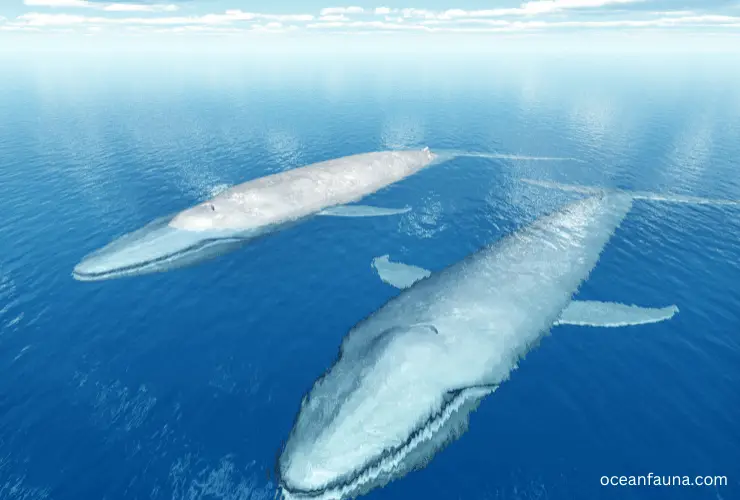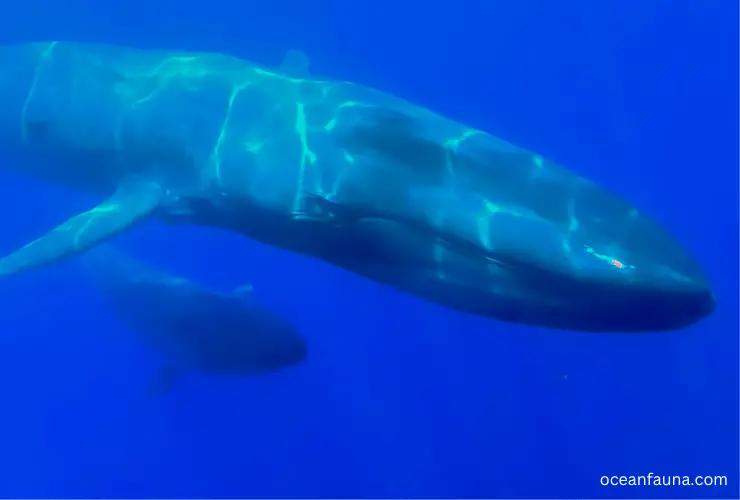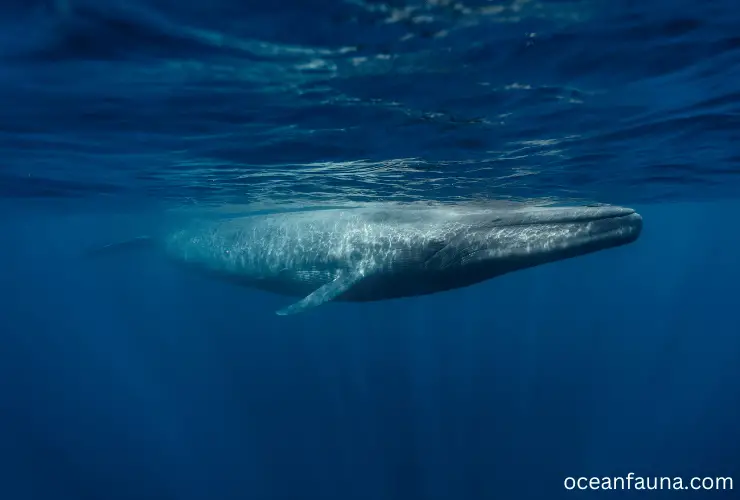How deep a blue whale can dive in a single breath depends on the age, species, and health of the blue whale, including the overall water condition of that region. According to research, on average, an adult blue whale can dive down up to 1500 feet (457 meters) deep.
In this blog, I will discuss the fascinating facts about the diving of blue whales and how far they can plunge underwater, including those factors impacting their diving ability.
How Deep Can a Blue Whale Dive?

Blue whales, scientifically known as Balaenoptera musculus, are usually shallow divers and can typically be found at depths of no more than 100 meters. Still, they are also capable of diving down to much greater depths. According to research, adult blue whales can dive down to an impressive depth of 1500 feet (457 meters). This is more than five times the depth that they normally frequent while foraging for their prey.
The blue whale can dive to such extreme depths due to its incredibly streamlined and aerodynamic body shape. Their hydrodynamic bodies minimize drag and allow them to move more efficiently through the water, conserving energy while diving.
Additionally, they have incredibly large lungs that allow them to take in more air and store it for longer periods than other marine mammals. This helps them stay underwater for longer periods, giving them more time to search for food and avoid predators.
What Is the Record of the Deepest Dive of a Blue Whale?
Although there has been much speculation surrounding the deepest dive made by a blue whale, the confirmed record remains at an impressive 506 meters (1,660 ft), accomplished by a pygmy blue whale.
Remember, this record is only for confirmed dives, and there may be deeper ones that have gone unrecorded. Nevertheless, this particular dive is impressive, especially considering the immense size of the pygmy blue whale.
The theoretical aerobic dive limit for blue whales has been estimated at 31.2 minutes, meaning they can hold their breath for this amount of time before resurfacing. However, the longest dive ever measured was only 15.2 minutes, indicating that these massive mammals typically don’t utilize their full potential when diving.
Which Factors Impact Blue Whales’ Diving Ability?

Here are the details of all the factors that impact how deep a blue whale can dive at a time.
Age of the Whales
Blue whales’ diving ability is affected by their age, with the older whales being able to dive deeper than younger ones. This is because, with age, the whales have a larger lung capacity and more developed musculature, allowing them to hold their breath for longer.
Sub-species of whales
The sub-species of the blue whale also have an impact on the depth of dive. The pygmy blue whale is known to be the deepest diver, while the Antarctic blue whale typically remains in shallower depths of up to 200-300 meters.
Health Condition of Whales
The health condition of blue whales greatly affects their swimming ability. Whales with underlying illnesses or injuries may not be able to dive as deep as healthy ones. Common health issues that can impact a whale’s diving ability include respiratory infections, ear, nose, and throat infections, and impaired lung function.
Water Conditions
The quality of water in which blue whales dive also plays a significant role in their deep diving. If the water is polluted, oxygen levels are compromised, or the water is infested with dangerous sea creatures, the whales might not be able to dive as deep as they usually would.
Moreover, the water’s temperature can also impact blue whales’ ability to dive, as colder temperatures can impair lung function and limit the length of time, they can hold their breath.
Food Availability
Food availability is also an important factor affecting blue whales’ underwater diving. In areas where there is plenty of food, the whales have no need to dive deeper in search of prey and can particularly stay near the surface. On the other hand, when food resources are scarce, they will have to go deeper into the ocean in an effort for them to feed.
Presence of Predators
The presence of predators is a significant factor that can impact the diving of blue whales. When they perceive a threat from predators like Great White sharks or killer whales, their tendency is to remain closer to the water’s surface, thereby restricting their ability to engage in deep dives. Additionally, encounters with a hunting pod of killer whales may compel them to plunge to greater depths in order to evade danger.
How Do Blue Whales Dive Underwater?

According to experts, it’s all about blue whales’ physiology. Before diving, blue whales begin to slow their heart rate and reduce their breathing rate, preparing their body for the upcoming dive by oxygenating the blood and conserving oxygen.
As they dive deeper, their body activates a process called the mammalian diving reflex. This reflex causes the blood vessels in their extremities to constrict, forcing blood towards their vital organs like the heart, lungs, and brain while reducing the blood flow to their muscles and other non-essential organs.
As the blue whale continues to descend, the pressure on their body increases. Their lungs compress to reduce buoyancy, and the air pockets in their bones help to maintain their posture.
However, the most significant change is in their heart rate. Blue whales can lower their heart rate from up to 70 beats per minute down to just a few beats per minute. This results in a decrease in oxygen consumption, allowing them to stay underwater for extended periods of time.
Blue whales may completely shut off blood flow to their non-essential organs like the kidneys, liver, and digestive system during their dive. This tactic allows them to divert more blood towards their vital organs, allowing them to function efficiently at depths of up to 1,000 feet. They may even remain under the water for up to 30 minutes.
As blue whales dive deeper, the water’s pressure increases, making it more difficult for them to resurface. To overcome this, they have a specialized circulatory system that allows them to store oxygen in their muscles and blood, which they can use when they resurface. This adaptation allows them to dive deep and still come up for air without any negative effects.
Blue whales switch their diving reflex off to resurface, resuming a normal heart rate and breathing pattern. As they ascend, they exhale carbon dioxide and inhale fresh oxygen in a “terminal dive” process before returning to the surface to take a breath.
How Fast Can a Blue Whale Swim?
Based on scientific research, blue whales can reach a remarkable 50 km/h speed over short bursts. This is mainly achieved when they are interacting with other whales or when a predator is chasing them. However, their usual traveling speed is around 20 km/h, which is still impressive given their massive size and weight.
When blue whales are feeding, they tend to slow down, and their speed reduces to around 5 km/h. This is because they have to maintain a consistent movement in the water to maximize their energy efficiency while filtering their prey.
Blue whales cannot maintain such fast swimming speeds for long periods despite their impressive speed. Their large size and weight require them to use a lot of energy to swim at high speeds, which they cannot sustain for long periods.
Another interesting fact is that blue whales have a streamlined and hydrodynamic body shape, which allows them to glide seamlessly through the water. Their unique body shape enables them to reach such high speeds with relative ease, making them one of the most impressive marine creatures.
FAQs
How long can blue whale hold their breath?
A blue whale can hold its breath underwater for up to 30 minutes. Although some researchers claim that they can hold their breath for up to 90 minutes, my research says a blue whale can’t hold their breath for that long. The reason is that the pressure becomes too much for their bodies to handle when they reach extreme depths, and they must resurface.
Additionally, they have impaired lung function, limiting the time they can hold their breath underwater. However, the deepest dive of a blue whale recorded was about 15.2 minutes.
How Deep Can a Baby Blue Whale Dive?
Unlike adult blue whales, baby whales are only able to dive up to 100 meters deep. They have smaller bodies and lungs than adults and rely on their mothers for nutrition. Thus, they don’t need to deep dive in order to feed themselves.
However, young blue whales can still be found diving deeper than average depths of 300-400 meters for short periods of time. This occurs when they interact with their mothers or other whales, learning how to dive and swim easily.
Conclusion
Now you have detailed information about the diving of blue whales underwater. At adult age, they can reach 1500 ft. depth. However, several factors can impact their deep dives, such as their age, species, health, food availability, water conditions, and the presence of predators or the need to avoid being hunted.
Additionally, they need to slow their heart and breathing rates to prepare for a dive. As they descend further underwater, they activate what is known as the mammalian diving reflex, which allows them to conserve oxygen and remain underwater for several minutes at a time.
If you have more queries regarding the diving capability of blue whales, feel free to ask.

